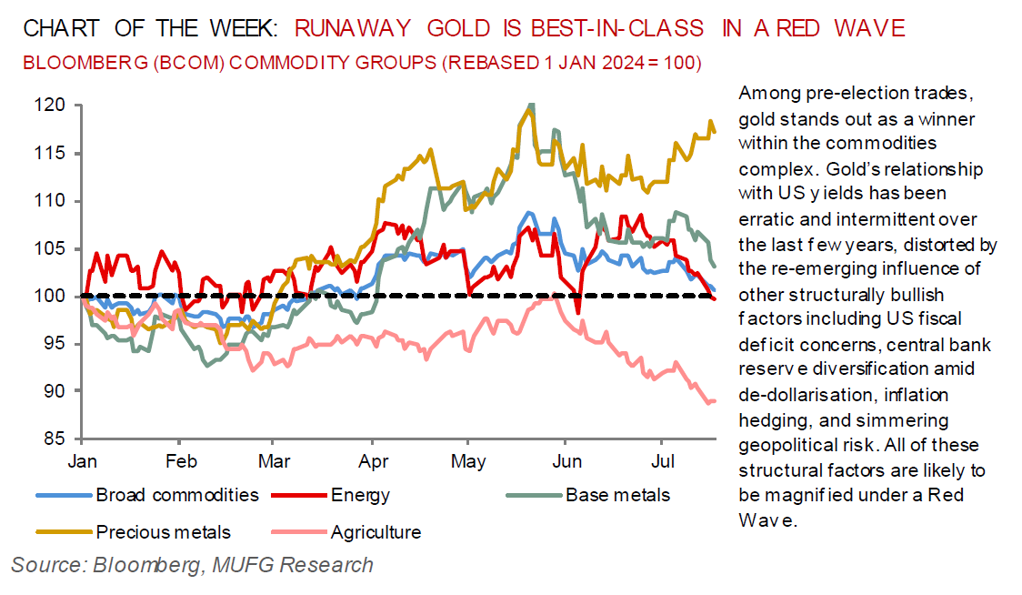To read the full report, please download the PDF above.
Re-examining implications for commodities under a Red Wave
EHSAN KHOMAN
Head of Commodities, ESG and
Emerging Markets Research –
EMEA
DIFC Branch – Dubai
T:+971 (4)387 5033
E: ehsan.khoman@ae.mufg.jp
SOOJIN KIM
Research Analyst
DIFC Branch – Dubai
T:+971 (4)387 5031
E: soojin.kim@ae.mufg.jp
MUFG Bank, Ltd.
A member of MUFG, a global financial group
We build on our recent examination of the implications for commodities stemming from the US elections to reassess what GOP control of all Washington levers of power could mean for the complex given the increased probability for a significant Red Wave. We make the following observations across the major commodities sub-components:
- Energy. For crude oil, candidate Trump aims to reduce inflation by raising US oil production by 3m b/d via deregulation, which is price bearish at face value. Yet, robust demand-side drivers (higher tariffs, lower taxes and stronger attempts to influence Fed policy via lower rates) as well as supply-side pressures (tighter sanctions on Iranian oil and heightened geopolitical uncertainty) will counterbalance such oil price bearishness. Meanwhile, a Red Wave congressional sweep could be even more bearish for US (and global) natural gas balances than we anticipate, given the expectations of an acceleration in US natural gas production (with risks of a re-emergence of Russian natural gas supply back onto global markets).
- Precious metals. A Red Wave will spur a return to higher rates with gold the standout best-in-class conviction across the entire commodities complex. Structural gold drivers such as US fiscal deficit complacency risks, tariffs, trade retaliations, central bank reserve diversification amid de-dollarisation, inflation hedging, and bullion’s role as a geopolitical hedge of first resort in a world given a return to “America First” rhetoric, are likely to be magnified under a Red Wave.
- Base metals. Tariff escalation risks (apparent via FX and economic growth) may overshadow structural bullish fundamental forces surrounding green transition base metals, such as copper, aluminium and nickel. Ultimately, the sequencing of policy precedence under a Red wave will be of first order importance in shaping the base metals complex.
- Agriculture. The prospect of a Red Wave raises possibilities of lower energy and fertiliser input costs on-farm, a stronger US agri growth outlook (especially for grains and cotton) driven by deregulation and a likely eventual ceasefire in Ukraine.
Energy
Oil’s anticipated summer rally is running out of steam, with Brent crude sinking to the lowest level is over six weeks, and on course for only its second monthly drop of the year. Low summer liquidity and algorithmic selling with commodity trading advisers (CTAs) dumping their bullish positions after futures surpassed both the 50-day and 100-day moving averages (support levels), have been predominantly behind the leg lower in crude in recent trading session.
Base metals
Copper has fallen to the lowest level since early April, on apprehensions that Chinese demand for base metals is weakening. We reiterate that the long-term outlook for copper is bullish via grid greenification, vehicle electrification, AI (vital for catalysing datacentres) and in military spending (in a deglobalised world). Yet, surging stockpiles in China signal that, until the outlook improves, there’s ample supply to feed demand.
Precious metals
Gold and silver is finding support, bolstered by India’s plans to cut its import tax on both gold and silver (from 15% to 6%) to support jewellery manufacturing. The Indian government also trimmed the import levy on platinum and palladium by 6.4% and 15.4%, respectively.
Bulk commodities
Iron ore is tumbling back below USD100/MT as China’s Third Plenum underwhelm market hopes for a major policy stimulus, with few measures to bolster the ailing property crisis.
Agriculture
Soybean prices are finding further support, after jumping the most in more than a year as uncertainty increased over the weather in August, alongside a resumption in investor bullish positioning.
Core indicators
Price performance and forecasts, flows, market positioning, timespreads, futures, inventories, storage and products performance are covered in the report.


